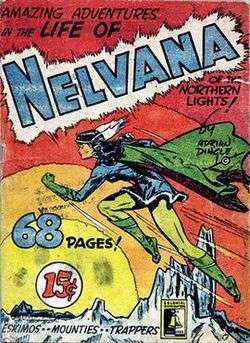Canadian Whites
Canadian Whites were World War II-era comic books published in Canada that featured colour covers with black-and-white interiors. Notable characters include Nelvana of the Northern Lights,[lower-alpha 1] Johnny Canuck, Brok Windsor, and Canada Jack. The period has been called the Golden Age of Canadian comics.
| Golden Age of Canadian Comic Books | |
|---|---|
 Adrian Dingle's Nelvana of the Northern Lights #2 (Hillborough Studios, October 1941) | |
| Time span | c.1941 – c.1947 |
Background
For the most part, the "Whites" had colour covers with interiors printed in black ink on white paper,[1][2] although there was a handful of comics with colour interiors.[1] They proliferated in Canada after the War Exchange Conservation Act[3] restricted the importation of non-essential goods from the United States into Canada, including fiction periodicals.[1]
Four companies took advantage of the situation by publishing comics in Canada, sometimes using imported scripts. Anglo-American Publishing of Toronto and Maple Leaf Publishing in Vancouver started publishing in March 1941. Later, two other Toronto-based publishers joined in: Hillborough Studios that August, and Bell Features (originally Commercial Signs of Canada[4]) in September.[1]
Some of the more notable "Whites" creators included Ed Furness, Ted McCall, Adrian Dingle, Gerald Lazare, Jon St. Ables, Fred Kelly, and Leo Bachle, all of whom would later be inducted into the Joe Shuster Award's Canadian Comic Book Creator Hall of Fame.[2]
This period has been called the Golden Age of Canadian comics,[5] but the age of the "Whites" did not last long.[2] When the trade restrictions were lifted following World War II,[lower-alpha 2] comic books from the United States were once again able to flow across the border.
Influence
The 2014 documentary "Lost Heroes: The Untold Story of Canadian Superheroes" began by covering this era.[10]
See also
Notes
- the first female Canadian superhero, predating Wonder Woman by several months
- the import prohibition was repealed, effective August 1, 1944,[6] but foreign exchange controls effectively prevented American comics from returning until the end of the war. The prohibition was revived in 1947[7] and continued until the end of 1950.[8][9]
References
- John Bell (2002-06-24). "Beyond the Funnies: Canadian Golden Age of Comics, 1941-1946". Library and Archives Canada. Archived from the original on 2011-10-07. Retrieved 2011-12-18.
- "Canadian Golden Age Comics Online". Joe Shuster Awards. Retrieved 2011-12-18.
- The War Exchange Conservation Act, 1940, S.C. 1940-41, c. 2
- Walter Durajlija (2011-11-22). "Undervalued Spotlight #103: Better Comics #1, Maple Leaf Comics, March 1941". comicbookdaily.com. Retrieved 2011-12-18.
- John Bell, ed. (1986). Canuck Comics. Special contributions from Luc Pomerleau and Robert MacMillan; Foreword by Harlan Ellison. Downsview: Matrix Books/Eden Press. ISBN 0-921101-00-7.
- An Act to amend The War Exchange Conservation Act, 1940, S.C. 1944, c. 50
- initially under "SOR/47-885". Canada Gazette, Part II. 81 (22): 2190–2204. November 26, 1947., until replaced by The Emergency Exchange Conservation Act, S.C. 1948, c. 7
- "SOR/50-573". Canada Gazette, Part II. 85 (1): 7. January 10, 1951.
- Kocmarek, Ivan (July 16, 2014). "FECA". comicbookdaily.com.
- https://www.thestar.com/life/2014/02/28/a_drink_with_a_producer_of_lost_heroes_documentary.html
Further reading
- Michael Hirsh; Patrick Loubert (1971). The Great Canadian Comic Books. Designed and illustrated by Clive Smith; Historical perspective by Alan Walker; Afterword by Harold Town. Toronto: Peter Martin Associates Ltd. ISBN 0-88778-065-2. LCCN 76174574.